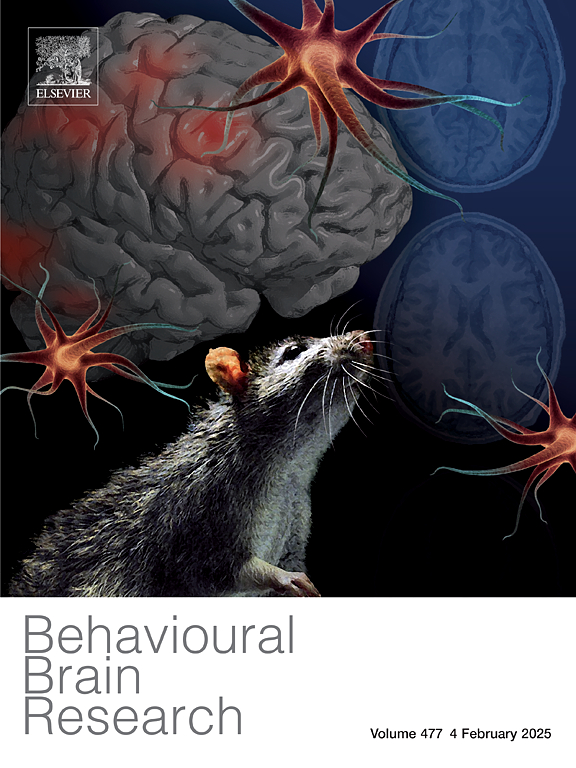Serotonin mitigates depression in a rotenone-induced mouse Parkinson’s disease model by inhibiting hippocampal neuronal pyroptosis and neuroinflammation
IF 2.3
3区 心理学
Q2 BEHAVIORAL SCIENCES
引用次数: 0
Abstract
Depression in Parkinson’s disease (dPD) is a prevalent comorbidity significantly impairing patients’ quality of life. Emerging evidence highlights the pivotal role of neuroinflammation in dPD pathogenesis, particularly the interaction between neuronal pyroptosis and microglial polarization. Serotonin (5-hydroxytryptamine, 5-HT) has been implicated in mood regulation and neuroinflammatory processes, yet its role in modulating pyroptosis and microglial polarization remains unclear. Therefore, this study aimed to investigate neuronal pyroptosis and microglial polarization in dPD pathogenesis and explore the regulation of 5-HT on these processes. A C57BL/6 mouse model of dPD was established using injected intraperitoneally of rotenone to observe changes in body weight, sucrose preference, and exercise time. ELISA and Western blotting were used to detect the expression of relevant proteins and cytokines in the hippocampus. Co-culture experiments with HT22 and BV2 cells were conducted to explore the effect of 5-HT on neuronal pyroptosis and microglial polarization. Rotenone-induced dPD in mice led to reduced body weight, sucrose preference, and activity, accompanied by upregulation of pyroptosis markers (NLRP1, N-GSDMD, Cleaved-caspase-1) and increased M1 microglial polarization. Treatment with 5-HT and the pyroptosis inhibitor Pep19–2.5 reversed these changes, mitigating neuronal pyroptosis and shifting microglial polarization towards a less inflammatory profile. In vitro, 5-HTP suppressed LPS-induced neuronal pyroptosis, reducing TNF-α, IL-1β, IL-18 levels and oxidative stress while preserving microglial viability. The 5-HT inhibitor Scopolamine abolished these effects. Neuronal pyroptosis and M1 microglial polarization contribute critically to dPD pathogenesis. By inhibiting these processes, 5-HT emerges as a promising therapeutic target for managing dPD, offering new insights into its treatment mechanisms.
血清素通过抑制海马神经元焦凋亡和神经炎症减轻鱼藤酮诱导的小鼠帕金森病模型的抑郁
帕金森病(dPD)的抑郁是一种普遍的合并症,显著损害患者的生活质量。新出现的证据强调了神经炎症在dPD发病机制中的关键作用,特别是神经元焦亡和小胶质细胞极化之间的相互作用。5-羟色胺(5-羟色胺,5-HT)参与情绪调节和神经炎症过程,但其在调节焦亡和小胶质细胞极化中的作用尚不清楚。因此,本研究旨在探讨dPD发病机制中的神经元焦亡和小胶质细胞极化,并探讨5-HT对这些过程的调控作用。通过腹腔注射鱼藤酮建立dPD小鼠C57BL/6模型,观察其体重、蔗糖偏好和运动时间的变化。ELISA和Western blotting检测海马组织中相关蛋白和细胞因子的表达。采用HT22和BV2细胞共培养实验,探讨5-HT对神经元焦亡和小胶质细胞极化的影响。鱼tenone诱导的小鼠dPD导致体重、蔗糖偏好和活性降低,并伴有焦亡标志物(NLRP1、N-GSDMD、Cleaved-caspase-1)上调和M1小胶质极化增加。用5-HT和焦亡抑制剂Pep19-2.5治疗可逆转这些变化,减轻神经元焦亡,并将小胶质细胞极化向炎症程度较低的方向转移。在体外,5-HTP抑制lps诱导的神经元焦亡,降低TNF-α、IL-1β、IL-18水平和氧化应激,同时保持小胶质细胞的活力。5-羟色胺抑制剂东莨菪碱消除了这些作用。神经元焦亡和M1小胶质细胞极化是dPD发病的关键因素。通过抑制这些过程,5-HT成为治疗dPD的一个有希望的治疗靶点,为其治疗机制提供了新的见解。
本文章由计算机程序翻译,如有差异,请以英文原文为准。
求助全文
约1分钟内获得全文
求助全文
来源期刊

Behavioural Brain Research
医学-行为科学
CiteScore
5.60
自引率
0.00%
发文量
383
审稿时长
61 days
期刊介绍:
Behavioural Brain Research is an international, interdisciplinary journal dedicated to the publication of articles in the field of behavioural neuroscience, broadly defined. Contributions from the entire range of disciplines that comprise the neurosciences, behavioural sciences or cognitive sciences are appropriate, as long as the goal is to delineate the neural mechanisms underlying behaviour. Thus, studies may range from neurophysiological, neuroanatomical, neurochemical or neuropharmacological analysis of brain-behaviour relations, including the use of molecular genetic or behavioural genetic approaches, to studies that involve the use of brain imaging techniques, to neuroethological studies. Reports of original research, of major methodological advances, or of novel conceptual approaches are all encouraged. The journal will also consider critical reviews on selected topics.
 求助内容:
求助内容: 应助结果提醒方式:
应助结果提醒方式:


